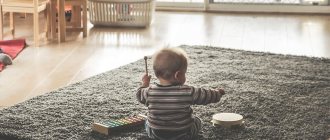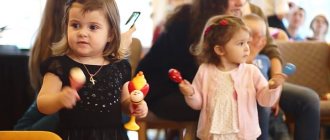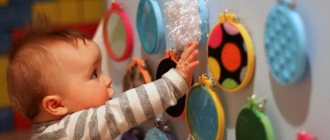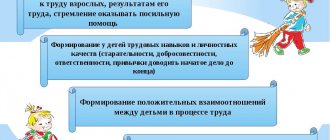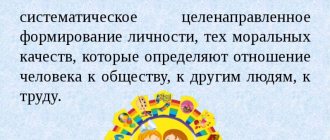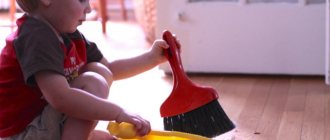Musical education in preschool educational institutions: objectives, forms of organization
Music opens the way to creativity for a child and promotes harmonious personal development. Music influences not only the development of musical abilities , but also contributes to the socialization of the child, and also shapes his spiritual culture.
The main tasks of music education :
- Introduction to the art of music ; formation of the foundations of musical culture , familiarization with elementary musical concepts and genres; education of emotional responsiveness when perceiving musical works .
- Development of musical abilities : poetic and musical ear , sense of rhythm, musical memory ; formation of song and musical taste .
- Cultivating interest in musical and artistic activities , improving skills in this type of activity.
- Development of children's musical and artistic creativity , implementation of independent creative activity of children; satisfying the need for self-expression.
Traditionally, in kindergarten, it is customary to distinguish four forms of organizing musical activities : Educational activities, independent musical activities of children , music in everyday life and on holidays, and music in the family .
Educational activity is the main form of work with children , during which systematic, purposeful and comprehensive education and formation of the musical abilities of each child is carried out. Educational activities include the alternation of various types of activities (singing, rhythmics, listening music , playing children's instruments, familiarization with the elements of musical literacy ) and thereby ensure the diversified development of children's musical abilities .
Unites children with common, joyful, aesthetic experiences, joint actions, teaches a culture of behavior, requires a certain concentration, manifestation of mental effort, initiative and creativity. independent musical activity will be more active, based on the knowledge, skills and abilities acquired through direct educational activities.
Holidays and entertainment will be more successful and interesting if children perform the songs, dances, and round dances they have learned expressively and naturally. Their structure and content depend on educational tasks and the age of the children . The content of the classes includes teaching singing, listening to music , rhythm, elements of musical literacy , and playing children's instruments. The amount of knowledge on these types of activities is determined by the program and objectives of music education for each age group of kindergarten.
The tasks of musical education are carried out: through singing, listening to music, musical-rhythmic movements, musical-didactic games. In older groups, the kindergarten education program provides for another means - playing musical instruments, in particular, the metallophone.
Each means that a teacher uses when carrying out the process of musical education, training and development of a child is a type of active, accessible to the child, artistic activity in the field of musical art.
Listening to music is an active internal process of concentration, requiring the mobilization of children's feelings, thoughts and cognitive abilities, united by the experience of a musical work. The child experiences various feelings in connection with the impact of music on him and comprehension of its content. This is a process of emotional-imaginative cognition, since it is carried out through an artistic and musical image. As a result, an attitude towards the image is formed, which is subsequently transferred to reality. Listening to music comes in different forms:
♦ as an integral part of any musical lesson, musical evening of leisure, holiday;
♦ as a special activity;
♦ as a methodological teaching technique.
Before learning a song with the children, the music director sings it to the children, and the children listen. Musical works for games, dances, and composition exercises are presented in the same way. The music director plays the piece, together with the children, determines its character, the number of parts, and draws attention to the most striking features.
In the form of a special lesson, listening is given with the aim of enriching children with musical impressions, accumulating and expanding their musical experience.
As a methodological technique, listening to music is used to help children learn to sing, play, and dance.
Singing is the active process of reproducing a melody with the voice and experiencing the content of the song. This is the main type of musical activity for preschool children.
All children from the age of two can and want to sing. While performing songs, they feel the music more deeply and express their emotions more actively. When choosing songs, it is necessary to take into account the age of the children, their vocal capabilities, level of musical development, as well as the educational orientation of the content of the songs.
Musical-rhythmic movements are active activities that reflect the nature of music in movement. Musical-rhythmic movements include musical games, dancing and exercises. The basis of musical-rhythmic education is the development in children of the ability to perceive musical images and the ability to reflect them in movement.
Musical-didactic games are a musical-sensory activity of a child, during which he learns to distinguish the properties of musical sounds, musical means of expression, and musical genres.
Playing children's musical instruments - metallophone and drums - is useful for the development of musical abilities: ear for music, sense of rhythm and musical memory.
Each means of musical education is associated with the development of musical perception. Together they instill in a child a love of music, deepen his perception and understanding of the environment, evoke a certain attitude towards him, and form musical taste. Each of the mentioned means of musical education has its own specifics, which is reflected in the teaching methodology. For example, if a teacher performs a song before the children start singing, then they will strive to imitate, perceive the work as a whole, and as a result will perform it better.
Preliminary listening to a song and its melody creates a general mood, restores previously formed temporary connections in the auditory analyzer of the cerebral cortex and helps the child correctly select the first sound. THEM. Sechenov pointed out that the memory for a vivid sensation is stronger the more recent it is, the more real the sensation, the fresher the impressions.
Preliminary listening to music for dancing or playing restores the musical image as a whole, affects the auditory and motor analyzers, and adjusts the child to the appropriate tempo and rhythm of movement. The very process of moving to music is an active process of perceiving music.
The specificity of each means of musical education is determined by its relationship to a specific type of musical art. Therefore, the content of software skills is built in accordance with the basics of this type of art. Thus, singing belongs to the field of choral art. Therefore, the content of program singing skills comes from the musical and theoretical foundations of choral singing.
Musical-rhythmic movement generally relates to the art of choreography and mainly to the basics of musical-rhythmic education. Therefore, the content of program movement skills comes from the foundations of musical-rhythmic education - rhythmics.
Listening to music is associated with seven types of art. It is based on concert and performing activities.
In the musical education of children, all of these means are interconnected. For example, singing, as mentioned above, involves both preliminary listening to the song and listening to it in the process of learning and performing. At the same time, singing in games and round dances is accompanied by movements.
Each means of musical education influences the others, and together they serve to develop musical abilities.
Listening to music develops a child's musical perception and helps him distinguish musical works. Since listening involves recognizing a piece of music, it contributes to the development of children's musical ear and especially its emotional component.
Singing—reproducing a melody with the voice—also contributes to the active development of musical and auditory perceptions. It develops both a modal sense (a sense of tonic, correct tuning) and a musical-rhythmic sense, since there is no melody without rhythm. Movement requires the child mainly to coordinate his actions with the nature of the music, with its tempo and rhythm, that is, he must simultaneously listen to the music. The same thing happens when children play musical instruments.
Thus, singing affects the success of movement, movement affects the success of singing, and listening affects both. All three main means of musical education act in the same direction - the development of musical abilities. In music classes, they are all necessarily used, since various forms of activity contribute to better assimilation of program skills.
The content of music education in kindergarten includes:
♦ objectives of musical education for each age group for all types of activities;
♦ program repertoire for all types of activities;
♦ program requirements for all types of activities;
♦ organizational forms of musical activity;
♦ methodological techniques for working with children for each age group.
The purpose and objective of educational activities
The goal and task of educational activities is to instill in preschoolers an interest in art, the ability to understand musical information , genres, musical forms , and to contribute to the formation of artistic taste in children.
Educational activity is the main form of educational activity in kindergarten and the educational process is carried out through direct instruction. In everyday life, the indirect guidance of the music director , teacher , and parents in the musical education of children .
Direct teaching in everyday life is not completely excluded, but it should be limited. Any musical communication with a child should be built on joint activity, partnership, encouraging his initiative in every possible way, which is especially important when children exhibit independent musical expressions . Music in the everyday life of a kindergarten combines all forms of musical activity : holidays, entertainment, morning exercises.
So, the form of organizing music education in the everyday life of a kindergarten provides for two types of guidance from the teacher , music director , and parents: direct and indirect. During games, educational exercises, and walks, music can be played at the request of both children and adults.
But in entertainment, holidays, morning exercises, this happens, as a rule, on the initiative of the teacher; at the same time, he must, of course, take into account the capabilities, interests and passions of the children. The interaction of the entire teaching staff is one of the signs of a highly effective organization of the educational process.
The music director creates conditions for children to acquire knowledge, skills and abilities in various types of musical activities , and the teacher helps to consolidate them.
In order for music to become firmly established in children’s lives, the music director needs to build interaction not only with the team of teachers, but also with parents. To do this, certain work is carried out with parents, during which it is necessary to ensure that they become conductors of the child’s cultural formation. Children and adults love general forms of interaction , and these are holidays, entertainment, competitions, quizzes.
Club work also contributes to the emergence of independent musical activity in children, both in a group and at home with their parents. the accumulated musical experience into everyday life in accordance with his interests and desires.
The emergence of independent musical activity in kindergarten is one of the indicators of a high level of development of children, characterized by certain musical skills and abilities , the ability to transfer a variety of musical activities into everyday life.
The child must be able to apply the accumulated musical experience , developed musical skills and abilities in new conditions, in independent musical activities according to his interests and desires.
What are the benefits of music as an educational tool?
Songs and melodies are practically the only art form that children can properly appreciate at such a young age. Even in the first months of life, babies react to melodies and can express their feelings about what they hear with their emotions. Through a lullaby, an attitude towards loved ones and art is formed.
Important
It is important to make music accessible to such a young age. For preschoolers, it is very difficult to listen to, understand and evaluate a piece of music with a duration of more than 5-7 minutes. Children simply will not be able to sit for more time in attention; this must be taken into account when planning lessons.
To solve the problem, you need to select short fragments for listening with maximum ease of comprehension. It is better to take those parts and passages that are used on television for intros to programs, in films, and in theatrical productions. Their impact on the subconscious has already been tested for years and is highly likely to cause a strong emotional response, as well as maximum results in the musical education of preschoolers.
More diagrams on the topic “Music in kindergarten”.
Types of musical activities
The standard defines age-appropriate activities, including musical activities for children.
In infancy (2 months - 1 year) - this is direct emotional communication with an adult, manipulation with objects and cognitive research activities, perception of music, children's songs and poems, motor activity and tactile-motor games.
At an early age (1 year - 3 years) - these are object-based activities and games with composite and dynamic toys, experimenting with materials and substances (sand, water, dough, etc.), communication with an adult and joint games with peers under the guidance of an adult, self-service and actions with household tools (spoon, scoop, spatula, etc.), perception of the meaning of music, fairy tales, poems, looking at pictures, motor activity.
For preschool children (3 years - 8 years) - this is a gaming activity, including role-playing games as the leading activity of preschool children, as well as games with rules and other types of games, communicative (communication and interaction with adults and peers), cognitive - research (studying objects of the surrounding world and experimenting with them), perception of fiction and folklore, self-service and basic household work (indoors and outdoors), construction from various materials, including construction sets, modules, paper, natural and other materials, visual arts (drawing, modeling, appliqué), musical (perception and understanding of the meaning of musical works, singing, musically rhythmic movements, playing children's musical instruments) and motor (mastery of basic movements) forms of activity of the child.
Based on the age-appropriate types of activities proposed by the Standard, it becomes possible to specify the forms of musical activity with children of early and preschool age (table). Please note that the proposed forms of a practice-oriented nature primarily grow out of the child’s cultural practices.
The role of parents in the musical education of children
Parents are the life guide for every child. How you relate to this world is how your son or daughter will relate to it. These are small sponges that absorb absolutely everything and record literally every movement of mom and dad. They are attuned to their parents on some instinctive, intuitive level. It is impossible to deceive a child; he will immediately feel falsehood and insincerity. Which means he will be disappointed in you.
That is why interest in music should be instilled in the family. And it must be sincere, coming from the heart. You shouldn't wait for a certain age. Scientists have proven that, even before being born, a child already actively reacts to harmony. He gets excited hearing music from outside. Especially when it comes to classical works.
That's why you need to cultivate a love of music even before the baby is born. Play appropriate records, sing children's songs, watch musicals and operas. All this will have a beneficial effect on the child’s development and will further serve as an excellent basis for the formation of an integral, self-confident and highly developed personality.
In order for a baby to understand and listen to music, his parents must understand and listen to music themselves. It doesn't work any other way. A little person receives his first knowledge and ideas from his close circle. And who is it? Mom, dad, grandmothers, grandfathers, brothers and sisters. But nature arranges it this way that parents become the center of a child’s life. He has been focused only on them for a very long time. Therefore, it is important to be an example - perhaps there are no other recipes.
Music helps to cope with anxiety, relieves depression, and puts you in a positive mood. It distracts you from everyday life, taking you to magical lands where there are no limits to your fantasies and dreams. The healing power of musical compositions chosen with taste and to suit the mood has long been known. But if parents do not teach this to their child, do not take him by the hand and lead him into the wonderful world of enchanting sounds, then it will be much more difficult. Of course, kindergarten and school will correct the situation, but don’t forget: everything comes from the family. This is where the foundations are laid. If you want to teach your child beauty, open it to music.
Musical games for parents and children
In fact, musical games between parents and children can take place at any stop. You can even play “Guess the Tune” in the car. From the first opening notes of the beginning composition, you should guess what it is playing. Or you can choose a topic and try to remember and even perform works that are somehow related to it. Whoever names more is well done.
These games don't even require special equipment. Try tapping the rhythm with your palms. Set the beat first, and then ask the child to do the same. You can use not only your palms, but also your knees or shoulders. In such activities, there is also direct interaction, which is so important for the baby - tactile contact.
Play with children, as has long been the custom among our people. For example, “the magpie-crow was cooking porridge” is a very interesting option, perceived with delight by children. Sing songs, put you to sleep with lullabies.
Turn on music and draw or dance to it. Organize impromptu home concerts and just don’t be afraid to get creative. Believe me, children really love it when they play with them!
Methods and techniques for musical education of preschool children
The following methods are used to form a musical culture:
- Contrastive comparison - a system of tasks has been developed that are based on listening to different interpretations of the same work. By contrast, students learn to understand the meaning of a work and break it down into its component parts.
- Assimilation to the character of the sound consists of an emotional adjustment to the sound and in expressing one’s attitude towards the works being listened to. Similarity can manifest itself in a variety of forms: singing along, dancing, choosing clothes, etc.
- Tactile assimilation - the teacher touches the child’s hand to set him up to listen to the musical playback for maximum insight into its essence.
- Mimic assimilation - when listening to works, children look at the teacher and expect his assessment of what is happening. To develop musical taste, you will need to show emotions that correspond to the nature of the work. For example, it is appropriate to smile, make a serious face, and show passion. Children in preschool age are subconsciously drawn to adults, copying their behavior and emotions.
- Intonation assimilation - when listening to compositions, you need to express your attitude in words and replicas. In preschool age, it is difficult for children to grasp the meaning of words, phrases or sentences if they explain the essence of the composition in difficult to understand language. Therefore, it is better to express your attitude to music in simple words that are understandable for children, but saturated with bright emotional coloring. They act directly on the subconscious, bypassing the stage of mental comprehension of what is heard.
- Color comparison - when listening to a composition, you need to show the students cards with colors and associate a certain color with the general mood of the work. For example, when listening to a calm composition, the color blue is shown; for an active and sound-rich song, you need to show the color red. When listening to subsequent melodies, you should ask the children what color this or that song is associated with.
Exercises for neuropsychological correction in childhood
Principles of education with musical works
It is necessary to select those classical and folk melodies that will become standards of beauty for children. The education program is guided by the following principles:
- Thematic - six themes are used that are repeated periodically. These are the following topics: fairy tales, nature, musical instruments, dancing, human characters, fine arts.
- Cyclic - all the above themes are repeated with a certain frequency, this will ensure the formation of a lasting musical taste.
- Contrastive comparison of the repertoire - teachers allow students to listen to several works of different genres. After this, children express their feelings and emotions regarding what they heard, learn to distinguish between a wide variety of genres.
- Adaptability - the teacher should not use technologies for musical education of preschoolers as a mandatory template. It is necessary to focus on the level of development of a group of children and select works according to purely individual tastes. If the majority liked a certain song or melody, then it should be given to listen to as often as possible.
- Syncretism - the works being listened to should encourage children to physical activity, improvisation, rhythmic plasticity, etc. All this ensures complex development. In the future, based on the listening works, you can stage performances and perform mini-scenes.
Step-by-step technique for drawing a portrait of a mother for children
